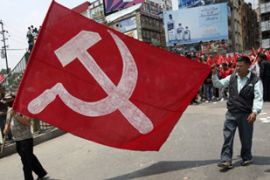Nepal’s PM resigns to end deadlock
Madhav Kumar Nepal quits on live television after months of pressure from Maoists.

“I had frequently urged the political parties including the Maoists to find an appropriate way out of the present deadlock and forge a consensus,” he went on.
“As it would be inappropriate to further prolong the situation of confusion and indecision, I decided to resign from the post of prime minister to help accomplish the
tasks of constitution drafting and the peace process.”
Political impasse
The three main parties in the country agreed last month to form a power-sharing government, but have been unable to hammer out details of what form it should take.
Rather than working together, each of the parties has been jostling for positions of power, creating a climate of political uncertainty and instability in the troubled country.
The prime minister, who took office in May 2009 after the Maoist-led government collapsed in a row over the failure to integrate the party’s former rebel fighters into Nepal’s armed forces, had the support of 22 political parties in parliament
and more than half of the 601 members in the assembly.
But he was unable to draw support from the Maoists, who have the largest number of seats in the assembly.
They had staged protests demanding that the government was disbanded, bringing Nepal to a complete standstill for a week in May when they organised a general strike.
The protests also set back the timetable for the writing of a new constitution, which was supposed to have been completed in May. The deadline was extended by a year when it became apparent that there was no sign of the stalemate being broken.
Prime Minister Nepal is expected to stay in the job in a caretaker capacity while his successor is chosen.